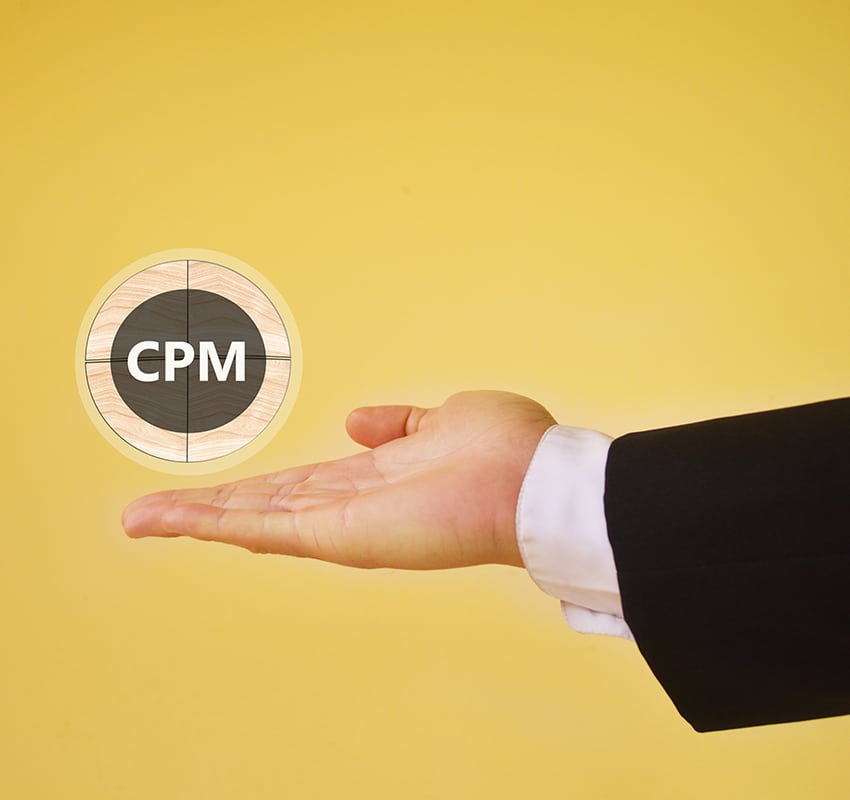eCPM vs CPM
Marketing is full of abbreviated terms, CPM and eCPM must rank as two of the most confusing concepts. With only one letter to set them apart, it's easy to see how they can be mistaken. But are they the same or different? This article will answer that question by defining CPM and eCPM, explaining how each model works, and how they compare to one another.
What is CPM?
CPM stands for Cost Per Mille, is a metric used in digital marketing to express the price rate of a given ad. Per the 'Mille' in its name, CPM represents the cost of every 1000 ad impressions that advertisers pay for that placement. Ad networks typically provide CPM-based choices for advertisers with a variety of pricing models for purchasing ad inventory. Ad networks also provide tools for real-time monitoring and optimization of ad campaigns. For example, if an ad was placed in a certain location with a CPM rate of $3.00, then it would cost the advertiser $3.00 for every 1000 ad impressions the ad receives.
CPM is often used to measure the effectiveness of an ad campaign by taking into account the best-performing ad cost. By calculating the total cost of an ad versus how many people are exposed to it. This analysis can help advertisers make more informed decisions on where to allocate their advertising budgets.
How to Calculate CPM
Effective CPM is a valuable metric that not only offers great insight but can also be easily calculated. To calculate CPM rate of an ad, you'll need to know two things:
1. The total number of impressions for the ad
2. The total amount of money spent on the ad
From there, those values go into the following formula to determine the CPM:
CPM = (Total Amount Spent / Total Ad Impressions) x 1,000

For example, if an ad was placed with a total cost of $150 and received 10,000 ad impressions, then its CPM rate would be calculated as follows:
CPM = ($150 / 10,000) x 1,000
= $15 CPM
In this case, CPM rate for this ad was $15.00.
It's important to note that CPM doesn't reflect the monetary returns
What Influences CPM?
CPM is the cost of one ad impression. To make it simpler to compare them, it is expanded to thousands. CPM rates are determined by a variety of factors, including the type and size of the ad placement, the overall quality of the ad, and the audience to whom it's being sent. Advertisers can raise brand recognition and create conversions by utilizing the features of ad networks. Let's take a closer look at each of these elements to better understand their influence on effective Cost Per Mille campaigns.
1. Ad Format
There are many different ad formats and types available to marketers today. Display ads, native ads, and video ads are a few of the ad formats utilized in CPM-based programmatic advertising.
Some, like video and interactive ads, typically have higher CPM rates because they are more engaging for users. Others, like banner ads, may have lower CPM rates due to their static nature and limited engagement capabilities. All formats have their strengths, but with respect to CPM, some outperform others.
2. Ad Size
The size of an ad also affects its CPM rate. Generally speaking, larger ads tend to have higher CPM rates as they are more visible and noticeable than smaller ones. This is especially true for display ads, where larger sizes are more likely to be seen and engaged with by users.
3. Ad Quality
While it can't be measured, ad quality has a major impact on CPM and other performance metrics. Ads that are well-crafted and optimized for target audiences tend to drive better results, particularly in terms of reach.
4. Audience
Ads targeted to more specific and niche audiences, such as those located in a certain geographic area or with particular interests to generate demand, tend to have higher CPM rates. This is because they are more likely to convert and generate a higher return on investment (ROI) for the advertiser.
What is eCPM?
An extension of CPM, eCPM stands for effective Cost-Per-Mille. It measures the combined price of ad impressions and click-throughs across multiple campaigns. This is done similarly: by dividing the total cost of a campaign by the total impressions or clickthroughs. The main difference is that eCPM doesn't just consider a single cost of a thousand impressions, rather, it consolidates many to churn out an average – or effective cost.
Ad Publishers, who manage multiple placements with different bidding models, often use this metric to manage the prices of their campaigns. The higher revenue is, the more ad revenue they're bringing in. To track their overall ad revenue, publishers should concentrate on eCPM.
Publishers' ad inventory sell by using a CPM or eCPM pricing model. Also, you can examine ad placements and formats on the pages with significant eCPM earnings. eCPM calculates the average of all advertiser bids for your ad impressions.
By using eCPM, you can normalize revenue rates and evaluate the amount of advertising revenue produced by various pricing structures across many factors, including geography, ad network, device, ad unit, and more.
How to Calculate eCPM
The process of eCPM calculation is very similar to that of CPM, only with an additional step. To start, you'll need two things:
1. The total amount of money earned across all campaigns
2. The total impressions or clickthroughs across all campaigns
Then, plug those into the following publishers advertisers formula:
eCPM = (Total Earnings / Total Ad Impressions) x 1,000
For instance, if a publisher earned $700 on 10,000 impressions across multiple campaigns, then the eCPM rate would be calculated as follows:
eCPM formula = ($700 / 10,000) x 1,000
= $70 eCPM
Publishers can use this metric to better understand their total earning potential and adjust campaigns accordingly.
Factors That Affect eCPM
Just like CPM, eCPM is affected by ad type, size, quality, and audience. Different ad units are commonly used in ad campaigns. Even slight differences in some of these elements can have a large impact on campaign performance, so it's important to be aware of their influence.
For example, if an ad type has lower CPM rates but is better suited for a particular audience, then its eCPM could potentially be higher due to the increased engagement from that target group.
Other considerations, such as viewability, fill rates, user device type, and visitor uniqueness, should also be taken into account. These can all affect how an ad is perceived and interacted with, leading to better or worse performance.
One important but often overlooked element, the number of campaigns running, can also impact eCPM. Averages may change drastically based on the number of inputs they have to calculate from, so it's important to be aware of this when analyzing performance.
eCPM vs CPM: What's the Difference?
The biggest difference between eCPM vs CPM is that the latter represents the amount of money an advertiser pays for 1000 ad impressions, while the former shows the average revenue generated from the same amount. eCPM vs CPM they're basically two sides of the same coin.
Let's see the difference between eCPM and CPM.
In addition to this, CPM focuses on a single campaign, while eCPM takes into account the performance of multiple campaigns. It's an average of many smaller CPMs, which gives publishers a more complete picture of total ad revenue.
And unlike CPM, eCPM isn't a fixed number. CPM expresses the rate of a single exchange of dollars and ad impressions. Because eCPM factors in more than one of those exchanges, its average can change over time.
eCPM vs CPM Examples
Need things illustrated a bit further? We've taken the liberty of creating these examples of how both eCPM vs CPM can be applied in the real world.
CPM Example #1
John is an online retailer with a website that sells clothing and accessories. He wants to generate more traffic to his site in order to increase revenue.
He decides to purchase a banner ad on a popular website. The cost of the ad is $5 CPM (cost per thousand ad impressions).
Assuming that the ad is seen by 10,000 people, the total cost of the ad would be $50 ($5 x 10,000 impressions).
The CPM model pays out a fixed rate per thousand ad impressions, regardless of any clicks or conversions the ad may generate.
CPM Example #2
Jane's travel agency recently wrapped a big marketing campaign promoting offers for Spring Break.
Looking at the numbers, she sees that the campaign yielded 4,000 impressions, while the total amount spent on the campaign was $45.
To determine the Cost per mille for this campaign, Jane would divide the total spend by the impressions received, and then multiply that number by 1000 ad impressions.
In this example, the CPM would be $11.25 ($45 / 4,000) x 1,000.
eCPM Example #1
Susan works for a publishing company that coordinates the sale and placement of advertising campaigns. She's been tasked with assessing a website's recent campaigns, which had CPMs of $1 and $2 and each generated one thousand impressions.
In this case, the total impressions for both campaigns was 2000 (1000 + 1000) and the total earnings were $3 ($1 + $2).
Using the formula for eCPM, we can calculate that Susan's website had an eCPM of $1.50 ($3 / 2000 x 1000). This figure tells her that, on average, the website earns $1.50 for every thousand impressions it serves and more revenue can be calculated on the same formula.
eCPM Example #2
John is a digital marketer who owns multiple websites. He has run multiple campaigns throughout the year, one for a fee of $5 CPM, another for $15 CPM, and a third for $20 CPM. He has a total of 100,000 impressions across these campaigns.
To calculate an increase eCPM, John would first add his earnings to get the sum of all three campaigns: $5 + $15 + 20 = $40. Then, he would divide that by the total impressions to get an average eCPM rate:
eCPM = ($40 / 100,000) x 1,000 = $0.40.
In this case, John's average eCPM rate is $0.40 – a relatively low figure due to the difference between CPM rates between his campaigns. Knowing his eCPM can help him make more informed decisions when it comes to managing and investing in future ones.
Final Thoughts
While they may sound similar, it's very clear that CPM and eCPM speak to very different parts of the advertising world. CPM is a straightforward model that illustrates the cost per thousand impressions of a particular ad, while eCPM works best for publishers looking to make money from their audience's attention. By taking the time to understand these two models, advertisers and publishers alike can ensure they're getting the most out of every ad.











